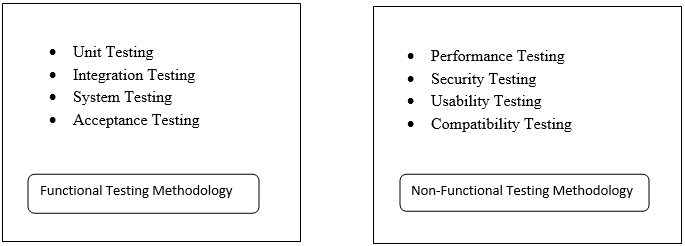Updated July 6, 2023
Introduction to Software Testing Methodologies
In Software Development or testing, both are given equal importance. So, let us see how Software Testing forms an integral part of Application Development. Software Testing is an integral part of any Development methodology, hence testing refer to Waterfall, Agile, and other QA methodology. Software Testing Methodology refers to the set of strategies and various types of testing employed to ensure that an application meets the requirements specified by the client.
There are two testing approaches,
- Preventive Approach: Tests are designed and initiated at an early stage, before the start of software development, to fix bugs before the build is initiated.
- Reactive Approach: Tests are designed after software development.
There are also other test approaches based on the requirement,
- Dynamic, Heuristic Approach
- Consultative Approach
- Risk-based testing Approach
- Methodical Approach
- Model-based Approach
- Standard Compliant Approach
The selection of test Approaches is based on the factors below,
- Experience with resources in proposed tools and techniques.
- External and Internal regulations of the development process
- Nature of the product and the domain
- Risk of product and Risk of failure for the company.
Types of Software Testing Methodologies
We have different types of Software Testing Methodologies, which are classified as Functional and Non-functional Testing.
1. Functional Testing
Functional Testing focuses on testing the application based on business requirements. It is broken into four components, Unit, Integration, System, and Acceptance Testing
- Unit Testing: Testing of individual software modules or components of an application. Developers write these types of tests in a TDD( Test Driven Development ) methodology such as Agile, Scrum, etc.
- Integration Testing: Testing of various modules or components of an application that are successfully unit tested are integrated together, which is also known as Scenario Testing or End-to-End Testing (E2E).
- System Testing: Testing of the entire application or system for bugs or errors.
- Acceptance Testing: It is the final phase of functional software testing and makes sure that all the project requirements are met, and the customer with the end-user has tested to make sure the application is operating as expected.
2. Non-Functional Testing
Non-Functional Testing focuses on testing the operational aspects of the application. It involves testing the application against non-functional requirements, which involve testing the application against pre-defined technical aspects, such as vulnerability, usability, and scalability.
- Performance Testing: Measures how a system behaves under increased load, be it the number of users or data volume. It can be classified into Load and Stress Testing. Load Testing verifies if the system can operate at the required response time when putting on load. Stress testing finds the failure point of the application where the system crashes.
- Security Testing: With the rise of cyber-attacks and cloud-based testing platforms, the need for securing data and storing it in software is a growing concern. Used to find loopholes and security breaches that can result in unauthorized access or loss of secured data.
- Usability Testing: It looks at end-user usability aspects of the software. The usability of the application forms the main testing part. Five aspects, learnability, efficiency, satisfaction, memorabilia, and testing the application as an end-user by logging in to it.
- Compatibility Testing: It tests that the product is compatible with all specified operating systems, hardware platforms, web browsers, mobiles, and other third-party plugins.
Let us explore some more Testing Types,
- Alpha Testing: Identifies all possible issues, bugs, or defects before releasing to the end-user
- Example Testing: Real-time testing includes real-time scenarios based on testers’ experience.
- Happy path Testing: To test an application on a positive flow without looking for negative flow or errors.
- Regression Testing: Testing an application as a whole for modification in functionality.
- Recovery Testing: It validates how well a system or application recovers from hardware/ software crashes or disasters.
Conclusion
Let us summarize what we have learned through this article and how Software Testing methodologies are useful in Software Development and Testing. Testing approaches and different testing methodologies. Also explored some of the different testing types; however, there is a list of more than 100+ types of testing that are not used in all types of projects. These testing types, processes, methodologies, its implementations keep changing according to project requirements and scope.
Recommended Articles
This is a guide to Software Testing Methodologies. Here we discuss an introduction to Software Testing Methodologies, two different types explained in detail. You can also go through our other related articles to learn more –




